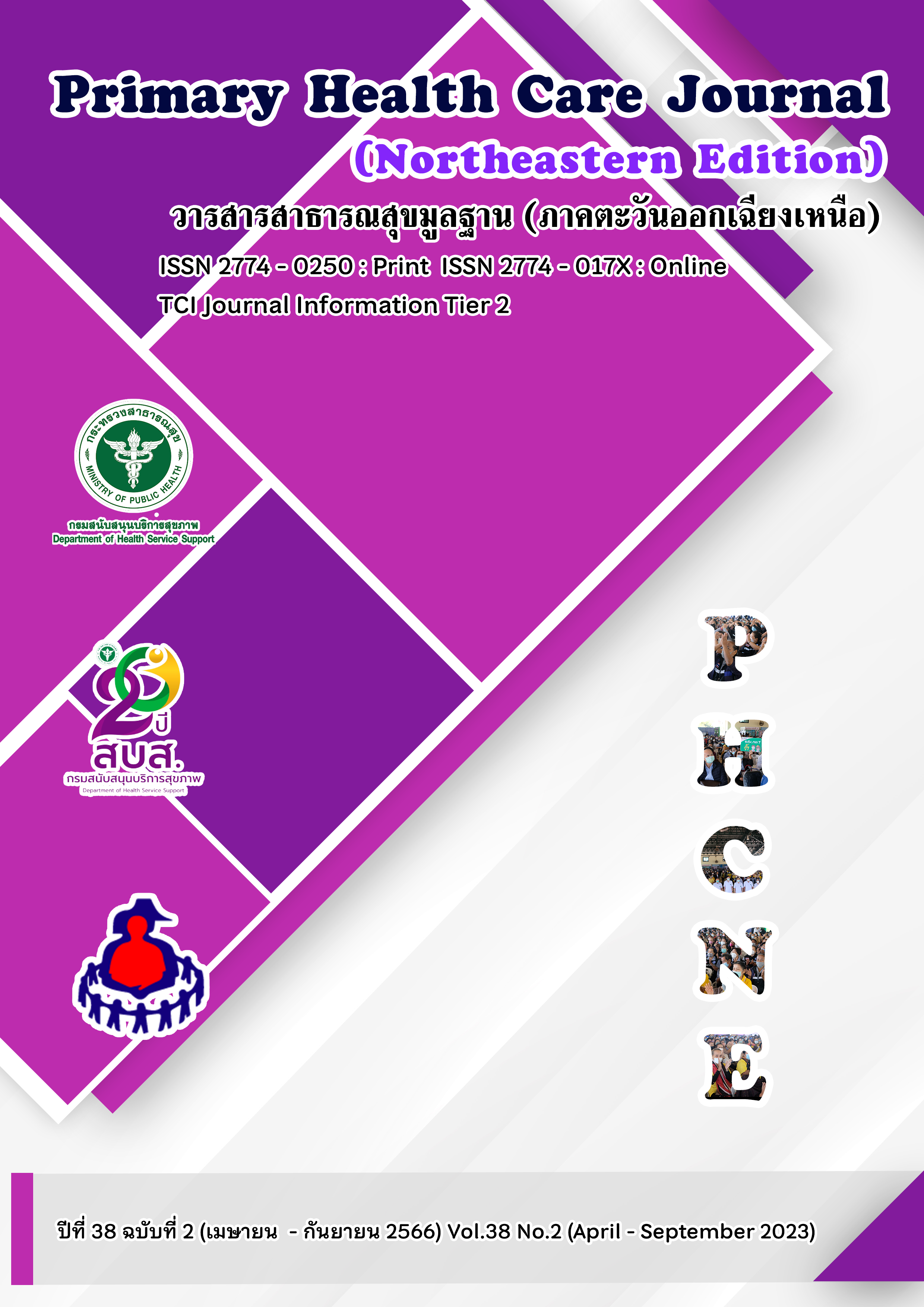DEVELOPMENT OF HEALTH LITERACY MODEL TO PROMOTE PREVENTING BEHAVIORS OF CORONAVIRUS DISEASE 2019 OF PEOPLE IN NAI MUEANG SUB-DISTRICT, MUEANG DISTRICT, CHAIYAPHUM PROVINCE
Keywords:
Health literacy, Preventing behaviors, COVID-19Abstract
This research and development aimed to develop Health Literacy Model to promote preventing behaviors of Coronavirus Disease 2019 (COVID-19) of people in Tambon Nai Mueang, Mueang District, Chaiyaphum Province which was divided into 2 phases; the first phase was to study on situation and factors that effected the preventing behaviors of COVID-19. This descriptive research was a cross sectional study from the sample of 968 participants by developed questionnaire. Meanwhile the second phase was to develop the Health Literacy Model to promote preventing behaviors of COVID-19 which was action research that was collected data on focus group discussion. The target group was 160 community representatives. The quantity data was analyzed by average statistics, standard deviation, number, percentage, paired sample t-tests, multiple regression analysis and the descriptive data was content analysis. The study found that effected factors on the preventing behaviors of COVID-19 were age, education, marriage status, income, health perception, and health behavior. In the meantime, the Health Literacy Model to promote preventing behaviors of COVID-19 included (1) potential development training of Village Health Volunteer (VHV) Leader, (2) outstanding COVID-19 prevention community award event, (3) system and communication channel development, (4) community health station establishment, and (5) supporting people’s health literacy. Moreover, results of the Health Literacy Model to promote preventing behaviors of COVID-19 have increased average score of the target group on COVID-19 health perception, preventing behaviors of COVID-19, and health literacy to prevent COVID-19 significantly. In conclusion, the study suggests that the results of this study ought to be applied to develop guidelines for promoting health literacy conform to community context. The researcher also suggested proposals for further study that long-term follow-up should be undertaken to further assess data accessibility and sustainability of the program as well.
References
กรมควบคุมโรค. (2565). สถานการณ์ผู้ติดเชื้อ COVID-19 ภายในประเทศ. เข้าถึงได้จาก https://ddc.moph.go.th/covid19-daily-dashboard/?dashboard=province (10 กุมภาพันธ์ 2566)
กรมสนับสนุนบริการสุขภาพ กระทรวงสาธารณสุข. (2563). รายงานผลการเฝ้าระวังสถานการณ์ความรอบรู้ด้านสุขภาพขั้นพื้นฐานและพฤติกรรมการดูแลสุขภาพในการป้องกันโรคโควิด-19 ของประชาชนครั้งที่ 1. (ม.ป.ป). นนทบุรี: กองสุขศึกษา.
กองสุขศึกษา กรมสนับสนุนบริการสุขภาพ. (2561). การเสริมสร้างและประเมินความรอบรู้ ด้านสุขภาพแลtพฤติกรรมสุขภาพ กลุ่มเด็กและเยาวชน (อายุ 7-14 ปี) กลุ่มประชาชนที่มีอายุ 15 ปี ขึ้นไป ฉบับปรับปรุง ปี 2561. (ม.ป.ป). นนทบุรี: กองสุขศึกษา.
เกษมสุข กันชัยภูมิ. (2565). การพัฒนารูปแบบการจัดการโรคติดเชื้อไวรัสโคโรนาสายพันธุ์ใหม่ 2019 (COVID-19) ด้วยกลไกการพัฒนาคุณภาพชีวิตระดับอำเภอ อำเภอคอนสวรรค์ จังหวัดชัยภูมิ. วารสารสุขภาพและสิ่งแวดล้อมศึกษา, 7(3), 66-75.
จงรัก สุวรรณรัตน์ และธณกร ปัญญาใสโสภณ. (2565). การพัฒนารูปแบบระบบความรอบรู้ด้านสุขภาพต่อพฤติกรรมสุขภาพและค่าน้ำตาลสะสมในผู้ป่วยโรคเบาหวานชนิดที่ 2. Journal of Nursing and Health Care, 40(2), 95-104.
เชษฐา งามจรัส. (2564). การคำนวณตัวอย่างสำหรับงานวิจัยด้านวิทยาศาสตร์สุขภาพ. (พิมพ์ครั้งที่ 1). ขอนแก่น: มหาวิทยาลัยขอนแก่น.
ณัฐสุดา คติชอบ และคณะ. (2566). การส่งเสริมความรอบรู้ด้านสุขภาพของวัยทำงานเพื่อป้องกันโรคไม่ติดต่อเรื้องรัง: บทบาทพยาบาลสุขภาพชุมชน. วารสารพยาบาลศาสตร์และสุขภาพ, 46(1), 7–20.
ธีระ วรธนารัตน์, ภัทรวัณย์ วรธนารัตน์ และอารียา จิรธนานุวัฒน์. (2565). การบริหารจัดการภาวะวิกฤตในช่วงสถานการณ์การระบาดของโควิด-19 ระลอกแรก. วารสารวิจัยระบบสุขภาพ, 16(3), 370–389.
บัณฑิต เกียรติจตุรงค์. (2564). การพัฒนารูปแบบการมีส่วนร่วมของภาคีเครือข่ายในการป้องกันและควบคุมโรคติดเชื้อไวรัสโคโรนา 2019 (COVID - 19) อำเภอเมืองยาง จังหวัดนครราชสีมา. วารสารสำนักงานสาธารณสุขจังหวัดขอนแก่น, 3(2), 193-206.
ปรเมษฐ์ กิ่งโก้. (2566). การพัฒนารูปแบบระบบการบริหารจัดการภาวะฉุกเฉิน การระบาดโรคโควิด 19 จังหวัดอุดรธานี. วารสารสำนักงานป้องกันควบคุมโรคที่ 7 ขอนแก่น, 30(1), 1-13.
รัชนี เต็มอุดม และคะณะ. (2564). การพัฒนารูปแบบการป้องกันโรคติดเชื้อไวรัสโคโรนา 2019 โดยการมีส่วนร่วมของชุมชน ในจังหวัดนครพนม. วารสารสำนักงานป้องกันควบคุมโรคที่ 7 ขอนแก่น, 28(1), 1-13.
วลัยพร พัชรนฤมล, วริศา พานิชเกรียงไกร, และอังคณา เลขะกุล. (2563). การพัฒนากรอบยุทธศาสตร์ด้านสาธารณสุขเพื่อตอบสนองต่อการระบาดของโรคติดเชื้อไวรัสโคโรนา 2019 ของประเทศไทย. มูลนิธิเพื่อการพัฒนานโยบายสุขภาพระหว่างประเทศ. เข้าถึงได้จาก https://kb.hsri.or.th/dspace/bitstream/handle/11228/5275/hs2614.pdf?sequence=1&isAllowed=y (10 กุมภาพันธ์ 2566)
วิโรจน์ ตั้งเจริญเสถียร, วลัยพร พัชรนฤมล, วุฒิพันธุ์ วงษ์มงคล และวันวิสาห์ แก้วขันแข็ง. (2563). การสังเคราะห์มาตรการและนโยบายของรัฐบาลเพื่อลดการแพร่ระบาดของเชื้อโควิด-19 จากผลการประเมินการปฏิบัติตนของประชาชนไทยต่อมาตรการต่าง ๆ. มูลนิธิเพื่อการพัฒนานโยบายสุขภาพระหว่างประเทศ. เข้าถึงได้จาก https://kb.hsri.or.th/dspace/bitstream/handle/11228/5273/hs2608.pdf?sequence=1&isAllowed=y (10 กุมภาพันธ์ 2566)
วิลัยวรรณ ปัดถา, ชนัญญา จิรพรกุล และเนาวรัตน์ มณีนิล. (2022). ความรอบรู้ด้านสุขภาพ ปัจจัยที่มีความสัมพันธ์กับความรอบรู้ด้านสุขภาพในการป้องกันโรคติดเชื้อไวรัสโคโรนา 2019 ของครูชั้นประถมศึกษา อำเภอเมือง จังหวัดบึงกาฬ. วารสารวิชาการสาธารณสุขชุมชน, 8(3), 37-47.
วิไล มีทองขาว, อดิศร วงศ์คงเดช และสันติสิทธิ์ เขียวเขิน. (2022). การจัดการป้องกันและควบคุมโรคติดเชื้อไวรัสโคโรนา 2019 โดยชุมชนมีส่วนร่วม ตำบลโคกชำแระ อำเภอทุ่งศรีอุดม จังหวัดอุบลราชธานี. วารสารสำนักงานป้องกันควบคุมโรคที่ 7 ขอนแก่น, 29(2), 37-47.
สุภาภรณ์ วงธิ. (2564). ปัจจัยที่ส่งผลต่อพฤติกรรมการป้องกันโรคติดเชื้อไวรัสโคโรนา 2019 ของอาสาสมัครสาธารณสุขประจำหมู่บ้าน จังหวัดสุโขทัย. (ปริญญาสาธารณสุขศาสตรมหาบัณฑิต). คณะสาธารณสุขศาสตร์: มหาวิทยาลัยนเรศวร.
หทัยกาญจน์ ยางศรี, ประภาเพ็ญ สุวรรณ และสุรีย์ จันทรโมลี. (2021). การพัฒนารูปแบบความรอบรู้ด้านสุขภาพในชุมชนเพื่อป้องกันการติดโรคพยาธิ ใบไม้ตับ ในจังหวัดบึงกาฬ. วารสารควบคุมโรค, 47(1), 848-858.
Abel, T., & McQueen, D. (2020). Critical health literacy and the COVID-19 crisis. Health Promotion International, daaa040. doi.org/10.1093/heapro/daaa040
Bloom BS. (1968). Mastery learning. UCLA – CSEIP evaluation comment. Losangeles: University of California at Los Angeles.
Brooks, S. K., Webster, R. K., Smith, L. E., Woodland, L., Wessely, S., Greenberg, N., & Rubin, G. J. (2020). The psychological impact of quarantine and how to reduce it: Rapid review of the evidence. Lancet (London, England), 395(10227), 912–920. doi.org/10.1016/S0140-6736(20)30460-8
Chen, X., Ran, L., Liu, Q., Hu, Q., Du, X., & Tan, X. (2020). Hand Hygiene, Mask-Wearing Behaviors and Its Associated Factors during the COVID-19 Epidemic: A Cross-Sectional Study among Primary School Students in Wuhan, China. International Journal of Environmental Research and Public Health, 17(8), 2893. doi.org/10.3390/ijerph17082893
Chu, D. K., Akl, E. A., Duda, S., Solo, K., Yaacoub, S., & Schünemann, H. J. (2020). Physical distancing, face masks, and eye protection to prevent person-to-person transmission of SARS-CoV-2 and COVID-19: A systematic review and meta-analysis. Lancet (London, England), 395(10242), 1973–1987. doi.org/10.1016/S0140-6736(20)31142-9
Ebrahim, S. H., Ahmed, Q. A., Gozzer, E., Schlagenhauf, P., & Memish, Z. A. (2020). Covid-19 and community mitigation strategies in a pandemic. BMJ (Clinical Research Ed.), 368, m1066. doi.org/10.1136/bmj.m1066
Fung, I. C., & Cairncross, S. (2006). Effectiveness of handwashing in preventing SARS: A review. Tropical Medicine & International Health, 11(11), 1749–1758. doi.org/10.1111/ j.1365-3156.2006.01734.x
Hung, S.-C., Yang, S.-C., & Luo, Y.-F. (2021). New Media Literacy, Health Status, Anxiety, and Preventative Behaviors Related to COVID-19: A Cross-Sectional Study in Taiwan. International Journal of Environmental Research and Public Health, 18(21), 11247. doi.org/10.3390/ijerph182111247
Munnoli, P. M., Nabapure, S., & Yeshavanth, G. (2022). Post-COVID-19 precautions based on lessons learned from past pandemics: A review. Journal of Public Health, 30(4), 973–981. doi.org/10.1007/s10389-020-01371-3
Nutbeam, D. (2000). Health literacy as a public health goal: A challenge for contemporary health education and communication strategies into the 21st century. Health Promotion International, 15(3), 259–267. doi.org/10.1093/heapro/15.3.259
Rudd, R., & Baur, C. (2020). Health literacy and early insights during a pandemic. Journal of Communication in Healthcare, 13(1), 13–16. doi.org/10.1080/17538068.2020.1760622
Spring, H. (2020). Health literacy and COVID‐19. Health Information and Libraries Journal, 37(3), 171–172. doi.org/10.1111/hir.12322
WHO. (2021). COVID-19 Strategic Preparedness and Response Plan (SPRP 2021). https://www.who.int/publications-detail-redirect/WHO-WHE-2021.02
Wilder-Smith, A., Chiew, C. J., & Lee, V. J. (2020). Can we contain the COVID-19 outbreak with the same measures as for SARS? The Lancet. Infectious Diseases, 20(5), e102–e107. doi.org/10.1016/S1473-3099(20) 30129-8
World Health Organization. (2022). Coronavirus (COVID-19) Dashboard. https://covid19.who.int
Downloads
Published
How to Cite
Issue
Section
License
Copyright (c) 2023 ศูนย์พัฒนาการสาธารณสุขมูลฐาน ภาคตะวันออกเฉียงเหนือ จังหวัดขอนแก่น กรมสนับสนุนบริการสุขภาพ กระทรวงสาธารณสุข

This work is licensed under a Creative Commons Attribution-NonCommercial-NoDerivatives 4.0 International License.




